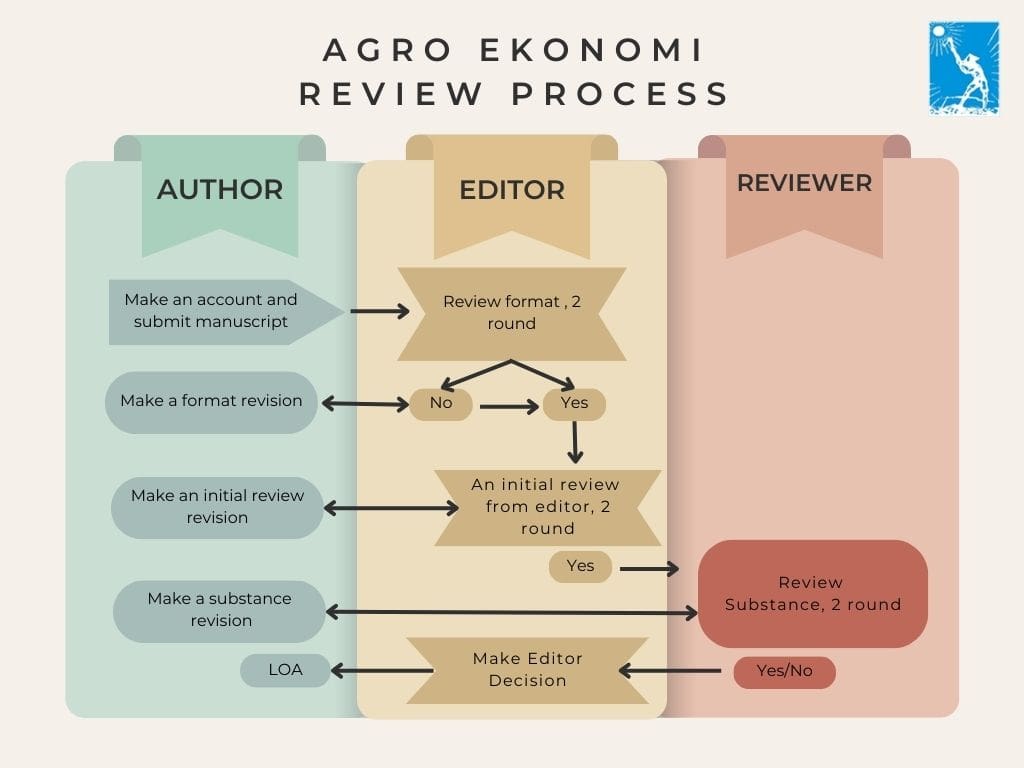Leading Agricultural Subsectors in South Sumatra Province Before and During The COVID-19 Pandemic
Muhammad Aris Pujiyanto(1*), Dwidjono Hadi Darwanto(2), Jangkung Handoyo Mulyo(3)
(1) Lecture Agribusiness, Universitas Muria Kudus
(2) Department of Agricultural Socio-Economics, Faculty of Agriculture, Universitas Gadjah Mada
(3) Department of Agricultural Socio-Economics, Faculty of Agriculture, Universitas Gadjah Mada
(*) Corresponding Author
Abstract
The COVID-19 pandemic that started in Wuhan, China, in December 2019 has resulted a very fatal health problems in global history, including for the State of Indonesia, which was confirmed that the first case of COVID-19 appeared on March 2, 2020. The COVID-19 pandemic not only having an impact on the health sector, the economy, international trade, industry but also having a negative impact on the agricultural sector, so that the production and productivity of the agricultural sector during the COVID-19 pandemic experienced a significant decline. So it is necessary to conduct more in-depth research to find out how much impact the COVID-19 pandemic has on leading agricultural sub-sectors in South Sumatra Province. This study aims to determine the leading agricultural sub-sector before and during the COVID-19 pandemic in South Sumatra Province. This study uses secondary data in 2010-2021. The analysis applied in this study is the analysis of Location Quotient (LQ), Dynamic Location Quotient (DLQ), and a combination of analysis of Location Quotient (LQ) and Dynamic Location Quotient (DLQ). The plantation crops sub-sector and the forestry sub-sector are the base sectors. The food crops sub-sector, horticultural crop sub-sector, livestock sub-sector, and forestry sub-sector have a faster growth rate when compared to the same sub-sector at the national level. Only the forestry sub-sector is included in the classification of the leading sub-sector.
Keywords
Full Text:
PDFReferences
Alhowaish, A. (2015). Location Quotient Technique and Economy Analysis of Regions: Tabuk Province of Saudi Arabia as a Case Study. International Journal of Science and Research (IJSR), 4(12), 1756–1761. https://doi.org/10.21275/v4i12.NOV152375
Bank Indonesia. 2021. (t.t.). Diambil 20 Januari 2022, dari https://www.bi.go.id/id/publikasi/laporan/lpp/Pages/Laporan-Perekonomian-Provinsi-Sumatera-Selatan-Mei-2021.aspx
Berawi, M. A., Zagloel, T. Y., Miraj, P., & Mulyanto, H. (2017). Producing Alternative Concept for the Trans-sumatera Toll Road Project Development using Location Quotient Method. Procedia Engineering, 171, 265–273. https://doi.org/10.1016/j.proeng.2017.01.334
Billings, S. B., & Johnson, E. B. (2012). The location quotient as an estimator of industrial concentration. Regional Science and Urban Economics, 42(4), 642–647. https://doi.org/10.1016/j.regsciurbeco.2012.03.003
BPS Prov Sumatera Selatan. (t.t.). Diambil 20 Januari 2022, dari https://BPS.bps.go.id/publication/2021/11/03/29c726f3052f738ead47cdf7/produk-domestik-regional-bruto-kabupaten-kota-di-provinsi-sumatera-selatan-menurut-lapangan-usaha-2016-2020.html
Carroll, M., Reid, N., & Smith, B. (2008). Location Quotients Versus Spatial Autocorrelation in Identifying Potential Cluster Regions. The Annals of Regional Science, 42, 449–463. https://doi.org/10.1007/s00168-007-0163-1
Chiang, S. (2009). Location quotient and trade. The Annals of Regional Science, 43(2), 399–414. https://ideas.repec.org/a/spr/anresc/v43y2009i2p399-414.html
Ellison, G., & L. Glaeser, E. (2015). Geographic Concentration in U.S. Manufacturing Industries: A Dartboard Approach. Journal of Political Economy. https://doi.org/10.1086/262098
Figueiredo, O., Guimaraes, P., & Woodward, D. (2009). Localization economies and establishment size: Was Marshall right after all? Journal of Economic Geography, 9(6), 853–868. https://doi.org/10.1093/jeg/lbp007
Flegg, A. T., & Tohmo, T. (2013). Regional Input–Output Tables and the FLQ Formula: A Case Study of Finland. Regional Studies, 47(5), 703–721. https://doi.org/10.1080/00343404.2011.592138
Guimarães, P., Figueiredo, O., & Woodward, D. (2009). Dartboard tests for the location quotient. Regional Science and Urban Economics, 39(3), 360–364. https://doi.org/10.1016/j.regsciurbeco.2008.12.003
He, Y., & Yin, P. (2015). Research on the Character of Tourism Destination Network of Capital Region of China. Dalam Z. Zhang, Z. M. Shen, J. Zhang, & R. Zhang (Ed.), LISS 2014 (hlm. 801–807). Springer. https://doi.org/10.1007/978-3-662-43871-8_115
Islam, F. B., Mubassirah, F. A., Siddiq, F., Hossain, D., Sharmin, N., & Haque, A. (2015). Economic Growth Analysis of Six Divisions of Bangladesh Using Location Quotient and Shift-Share Method. Journal of Bangladesh Institute of Planners, 8, 10.
Jing, N., & Cai, W. (2010). Analysis on the spatial distribution of logistics industry in the developed East Coast Area in China. The Annals of Regional Science, 45(2), 331–350. https://doi.org/10.1007/s00168-009-0307-6
Kuncoro, M., & Idris, A. (2015). MENGAPA TERJADI GROWTH WITHOUT DEVELOPMENT DI PROVINSI KALIMANTAN TIMUR? Jurnal Ekonomi Pembangunan: Kajian Masalah Ekonomi dan Pembangunan, 11, 172. https://doi.org/10.23917/jep.v11i2.323
Leslie, T. F., Frankenfeld, C. L., & Makara, M. A. (2012). The spatial food environment of the DC metropolitan area: Clustering, co-location, and categorical differentiation. Applied Geography, 35(1), 300–307. https://doi.org/10.1016/j.apgeog.2012.07.008
Morrissey K. (2016). A location quotient approach to producing regional production multipliers for the Irish economy. Papers in Regional Science, 95(3), 491–506. https://doi.org/10.1111/pirs.12143
Nugroho, A. dwi. (2010). KOMODITAS UNGGULAN TANAMAN PANGAN DI PULAU JAWA. Agro Ekonomi, 17(1), Article 1. https://doi.org/10.22146/agroekonomi.17868
Oktavia, Z., Darwanto, D. H., & Hartono, S. (2015). Sektor Pertanian Unggulan di Sumatera Selatan. AGRARIS: Journal of Agribusiness and Rural Development Research, 1(2), 61–69. https://doi.org/10.18196/agr.129
Portal Informasi Indonesia—Kasus Covid-19 Pertama, Masyarakat Jangan Panik. (t.t.). Diambil 20 Januari 2022, dari https://indonesia.go.id/narasi/indonesia-dalam-angka/ekonomi/kasus-covid-19-pertama-masyarakat-jangan-panik
Prisma. (2020). Dampak Covid-19 di pertanian‒perspektif petani: Studi kualitatif terkait perubahan perilaku petani karena Covid-19 di empat provinsi target kerja PRISMA. Australia-Indonesia Partnership for Promoting Rural Income through Support for Markets in Agriculture.
Rozaki, Z. (2020). COVID-19, Agriculture, and Food Security in Indonesia. Reviews in Agricultural Science, 8(0), 243–260. https://doi.org/10.7831/ras.8.0_243
Shukla, A. (2000). Regional Planning and Sustainable Development. Kanishka Publishers, Distributors.
Sjafrizal. (2012). Ekonomi Wilayah dan Perkotaan. PT Rajagrafindo.
Statistik, B. P. (2021). Produk Domestik Bruto Indonesia 2010-2020. Badan Pusat Statistik (BPS) Indonesia.
Sudaryanto, T., & Suharyono, S. (2020). PENINGKATAN DAYA TAHAN PETANI DAN USAHA TANI TERHADAP PANDEMI COVID-19. 17.
Tohmo, T. (2004). New Developments in the Use of Location Quotients to Estimate Regional Input–Output Coefficients and Multipliers. Regional Studies, 38(1), 43–54. https://doi.org/10.1080/00343400310001632262
Trappey, A. J. C., Trappey, C. V., Liu, P. H. Y., Hsiao, C. T., Ou, J. J. R., & Chen, K. W. P. (2013). Location Quotient EIO-LCA Method for Carbon Emission Analysis. Dalam J. Stjepandić, G. Rock, & C. Bil (Ed.), Concurrent Engineering Approaches for Sustainable Product Development in a Multi-Disciplinary Environment (hlm. 367–377). Springer London. https://doi.org/10.1007/978-1-4471-4426-7_32
Wang, J. (t.t.). Industrial Clusters and Regional Economic Development in China: The case of Heilongjiang Province. 288.
Article Metrics
Refbacks
- There are currently no refbacks.
Copyright (c) 2018 Agro Ekonomi

This work is licensed under a Creative Commons Attribution-ShareAlike 4.0 International License.
View My Stats











